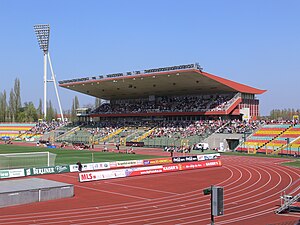Friedrich-Ludwig-Jahn-Sportpark
 |
|
| Location | Cantianstraße 24, D-10437 Berlin, Germany |
|---|---|
| Coordinates | 52°32′35″N 13°24′19″E / 52.54306°N 13.40528°ECoordinates: 52°32′35″N 13°24′19″E / 52.54306°N 13.40528°E |
| Public transit | Eberswalder Straße. |
| Owner | State of Berlin |
| Capacity | 19,708 |
| Record attendance | 30,000 (East Germany-Belgium, 13 March 1974) |
| Field size | 110 × 72 |
| Surface | Grass |
| Construction | |
| Opened | 1 October 1952 |
| Renovated | 1964, 1970, 1986/1987, 1998, 2015 |
| Architect | Rudolf Ortner |
| Tenants | |
|
Berliner FC Dynamo, SV Empor Berlin, FC Bundestag, Berlin Adler, 1965, 1990, 1991 FDGB Pokal Final, 2002, 2003 ISTAF Berlin, 1965-2006, 2008- Berliner Landespokal Final, German Junior Bowl XXIX, German Bowl XXXIV, German Bowl XXXV, 2015 UEFA Women's Champions League Final |
|
The Friedrich-Ludwig-Jahn-Sportpark is a sports site in the Prenzlauer Berg district of Berlin. It is bordered on the south by Eberswalder Straße, on the north by the Max Schmeling Halle, on the west by Mauerpark, where part of the Berlin Wall once stood. It includes a football and athletics stadium as well as several smaller sports fields. The stadium is the second largest in the city after Berlin's Olympiastadion with approximately 20,000 seats, of which 15,000 covered, and has temporarily been used by various Berlin football sides. Following its 2014 advance to the Regionalliga Nordost, Berliner FC Dynamo is now the main user of the stadium.
Since 1825, the area was used as the drill grounds of the Guard Regiment of the Prussian army. Some housing was constructed on the site late in the 19th century, but this was a short-lived use and the area soon became an open space used for sports. Between 1892 and 1904, the site served as the ground of Hertha BSC. The city of Berlin purchased the land in 1912 and developed it for sports use in 1913.
After World War II and the division of the capital city, the area was part of what became East Berlin, in the Soviet zone of occupation. A football and athletics stadium, with a capacity of 30,000 spectators, was built on the site in 1951, for use during the World Youth Festival that year. Known initially as Berliner Sportpark, East German municipal officials renamed the facility the Friedrich-Ludwig-Jahn-Sportpark the following year, to honour the centenary of the birth of the man known in Germany as the father of gymnastics. The stadium was refurbished in 1988 and its capacity reduced to the present-day number.
From 1963 to 1989, the facility hosted the Olympic Day of Athletics competition, modeled on a similar event staged each year in West Berlin. The meet saw the setting of several world records, including Uwe Hohn's record javelin throw of 104.80 meters on 20 July 1984 – the first time a throw of over 100 meters was made.
...
Wikipedia
